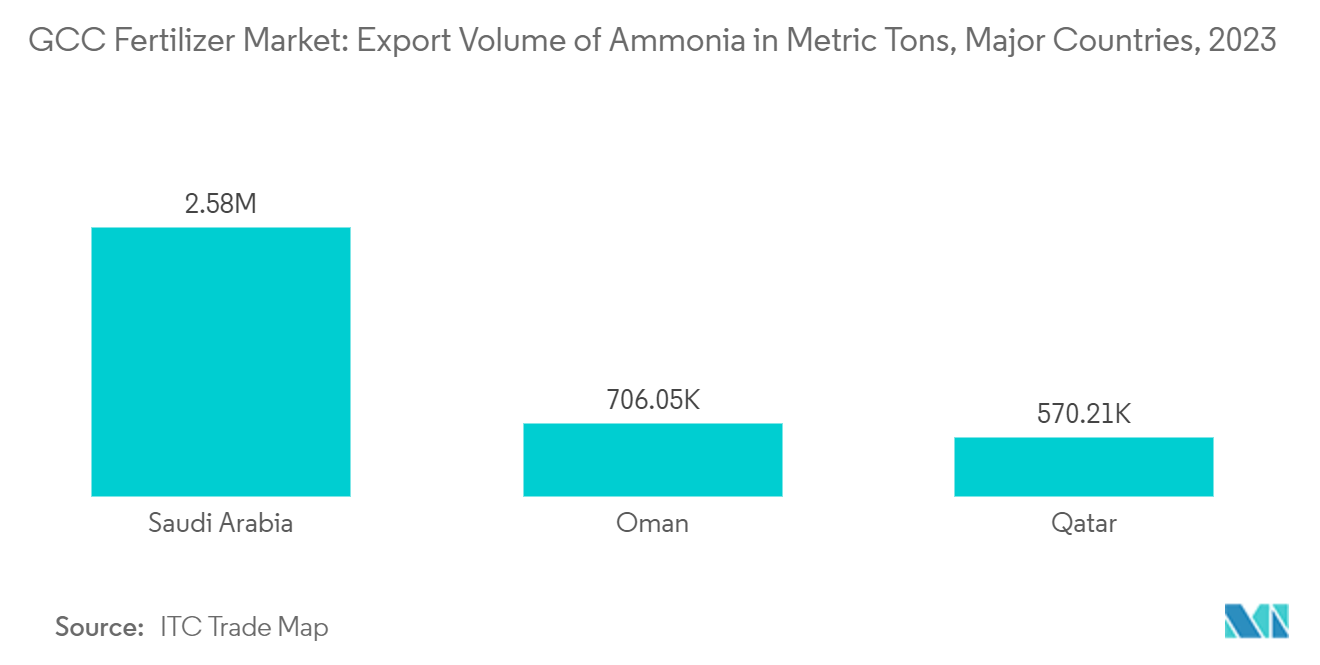Market Trends of GCC Fertilizer Industry
Nitrogenous Fertilizer Holds the Largest Share
Nitrogenous fertilizers dominate production in the GCC countries due to the abundant natural gas resources, which serve as a primary raw material. Consequently, urea and ammonia, each with a nitrogen content of 46%, are the most widely consumed nitrogenous fertilizers in the region. Their high domestic production ensures easy availability. According to FAOSTAT, Qatar's agricultural use of Calcium Ammonium Nitrate increased from 1,350 metric tons in 2021 to 1,370 metric tons in 2022.
Moreover, state-owned production facilities, along with abundant feedstock for urea and ammonia, significantly enhance the nation's production capabilities. The expansion of existing plants and the establishment of new units have led to a notable increase in production. Major domestic producers are scaling up ammonia output, and the adoption of green ammonia production is projected to further boost fertilizer output. For instance, in 2022, the Saudi Arabian Mining Company commenced commercial ammonia production across three plants, each with substantial annual output, poised to significantly impact the market during the forecast period.
Additionally, in the GCC countries, food demand is projected to rise, driven by macroeconomic improvements, a growing population, a thriving tourism sector, and government initiatives aimed at enhancing self-reliance. Changing consumer preferences and increased health awareness are fueling a surge in demand for innovative dining concepts and diverse cuisines. As the food services sector rapidly adapts to consumer needs, it emerges as a key driver of food consumption in the region. This trend is anticipated to bolster the demand for nitrogenous fertilizers in the coming years. Consequently, the projected steady increase in domestic nitrogenous fertilizer demand will drive market growth throughout the forecast period.

Saudi Arabia Dominates the Market
Fertilizer use in Saudi Arabia is a critical component of its agricultural strategy, especially given the country's arid climate and limited arable land. Saudi Arabia is the largest ammonia exporter in the GCC region, accounting for more than 40% of GCC output. The presence of well-established oil and gas industries and the availability of cheaper natural gas give the local players a competitive advantage of the low cost of production. According to the ITC Trade Map, in 2023, Saudi Arabia exported 2.5 million metric tons of ammonia followed by Oman (0.7 million metric tons), and Qatar (0.5 million metric tons). There are various potential sales destinations for Saudi Arabian ammonia producers in the Asia-Pacific, including China, Japan, South Korea, Thailand, and Vietnam. Arabian producers have a competitive advantage in supplying the Asian-Pacific region (especially South and South-East Asia) compared to its other European, African, and South American counterparts.
Saudi Arabia plays a pivotal role in the global urea market, exporting to numerous countries worldwide. According to the ITC Trade Map, in 2022, Saudi Arabia exported 551,818 metric tons of urea to the United States, making it the largest export market for Saudi fertilizers, with a significant 17.1% share by value. Other key markets for Saudi fertilizers included Australia, Thailand, India, and Bangladesh. With increased production capacity and a diversifying product portfolio, the industry is on a robust growth trajectory.
Furthermore, Saudi Arabia is the sole producer of NPK fertilizers in the GCC region. According to FAOSTAT, Saudi Arabia produced 9.6 million metric tons of NPK fertilizers in 2022, compared to 9.0 million metric tons in 2021. Companies such as Ma’aden Wa’ad Al Shamal Phosphate Company produce three million tons annually of the DAP/MAP/NPK complex in Saudi Arabia. In addition, the availability of natural gas at a competitive price in the country provides a significant advantage in terms of production costs. The ability of producers to operate plants efficiently and reliably makes the construction of export-oriented, integrated urea plants highly attractive. This is projected to drive the overall growth of the market during the study period.


